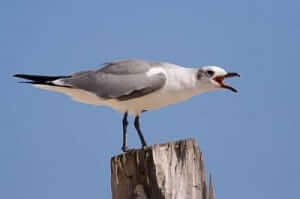Hmmmmm. Remember all those news stories that said the Deepwater Horizon oil spill was the greatest environmental disaster in history? You know, the ones that said the oil would devastate Gulf Coast wildlife for decades, that avian life would be decimated, that the Gulf Coast was a dead zone.
In the words of Saturday Night Live’s Emily Litella, “Never mind.” Turns out the Gulf Coast has never had so damn many birds.

Reuters has the avian info:
The 1,300-acre, man-made island is hosting more than 50,000 birds this summer as nesting pairs gather to raise babies. That number would be considered high in any year, but it’s a particularly surprising sight a year after oil from the BP spill fouled surrounding waters.
The Deepwater Horizon rig explosion spewed more than 168 million gallons of oil into the Gulf of Mexico over three months, the largest spill in U.S. history. But so far, there is no evidence of deformities or ill health among the young on Gaillard Island.
Scientists speculate that the baby boom probably results from an abundance of fish left undisturbed in waterways where the federal government banned commercial and recreational fishing last summer, providing a feast for shore birds.
Abundance of fish? But we thought the Gulf Coast waters were a dead zone in which nothing could live. But…but… but…
In a speech this spring, the executive director of the nearby Dauphin Island Sea Lab said the fish populations in that part of the Gulf were larger than he had ever seen.
The population of the pelicans, terns, laughing gulls, egrets, ibis and little blue and tricolored herons nesting on Gaillard Island is determined by the food supply, said Roger Clay, a wildlife biologist with the Alabama Division of Wildlife and Freshwater Fisheries.
Now hold on just a darn second. We thought the few fish that didn’t die in the oil were horribly sickened by it, had given birth to deformed little fish fingers and that they would all end up devastating animals further up the food chain.
“If something was wrong with the food, the first place it would show is with the birds,” said Clay, also known as the “the pelican guy.”
In other words, if something were wrong with the science and the scientists, this is also the first place it would show up.
But let’s not talk about that. Hey, look over there. It’s a bright, shiny object.
Source: Reuters

